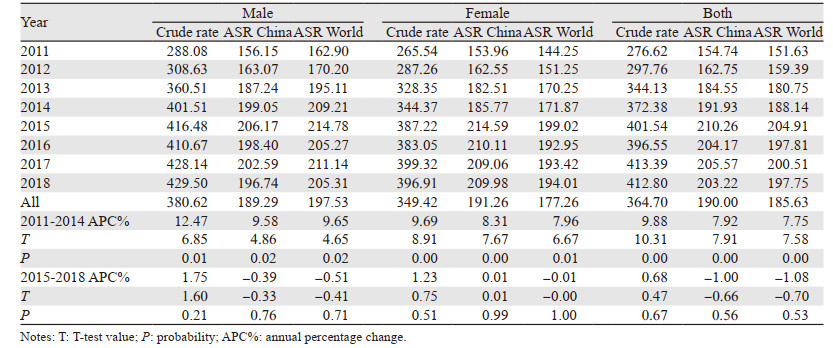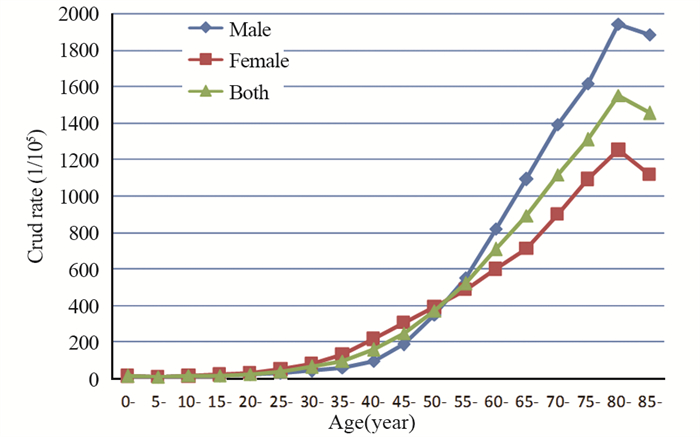文章信息
- 2011—2018年沈阳市城区恶性肿瘤发病及生存趋势分析
- Incidence and Survival Trend of Malignant Tumors in Shenyang Urban Area from 2011 to 2018
- 肿瘤防治研究, 2022, 49(8): 806-811
- Cancer Research on Prevention and Treatment, 2022, 49(8): 806-811
- http://www.zlfzyj.com/CN/10.3971/j.issn.1000-8578.2022.21.1533
- 收稿日期: 2021-12-30
- 修回日期: 2022-04-04
2. 471003 洛阳, 信息工程大学外国语学院
2. College of Foreign Languages, University of Information Engineering, Luoyang 471003, China
目前,全球癌症的发病和死亡人数仍在持续增长,2020年新发肿瘤1 929.3万例、死亡995.8万例,癌症在许多国家的死因顺位上已经超越心血管疾病等高死亡率慢性疾病[1]。沈阳市城区居民全死因中,恶性肿瘤也仅次于心脏病[2],严重危害沈阳人民健康。为了解沈阳市城区居民恶性肿瘤发病及生存情况,并提出防治措施,现对2011—2018年沈阳市城区居民恶性肿瘤发病及生存趋势进行分析。
1 资料与方法 1.1 资料来源2011—2018年沈阳市城区恶性肿瘤发病和生存资料来源于中国肿瘤登记中心肿瘤随访与登记报告系统。报告范围为具有沈阳市城市国家级监测点(和平区、沈河区、大东区、皇姑区和铁西区)户籍居民发病的全部恶性肿瘤(ICD10编码C00-C97)。人口资料来源于沈阳市公安局提供的每年份性别、年龄别的平均人口数。
1.2 质量评价根据《中国肿瘤登记工作指导手册》[3]和国际癌症研究中心(IARC)/国际癌症登记协会(IACR)[4-5]对登记质量的有关要求,对数据的可靠性、完整性、有效性进行评估。沈阳市城区肿瘤发病数据从2008年起连续五年被国际五大洲癌症协会收录,连续十年被中国肿瘤登记年报收录。沈阳市城区2011—2018年上报新发肿瘤数据质量评价为病理诊断率(MV%)为66.63%、只有死亡医学证明书比例(DCO%)为2.43%、死亡发病比(M/I)为0.65,均符合质量要求。
1.3 统计学方法提取2011—2018年沈阳城区恶性肿瘤发病数据,以国际疾病分类法ICD-10进行分类,并用IARCcrgTools软件进行数据审核。利用Excel2007计算粗发病率、标化率(中标率、世标率)、年龄别发病率、累积发病率(0~74岁)、截缩发病率(35~64岁)、前十位肿瘤发病顺位和生存率等指标;利用SPSS23.0统计软件对恶性肿瘤男女发病率及生存率进行χ2检验,检验水准α=0.05;采用寿命表法计算观察生存率,病例随访时间截止至2020-12-31;采用EdererⅡ方法(Ederer and Heise, 1959)计算期望生存率(expected survival rate, ESR)和相对生存率(relative survival rate, RSR);利用美国癌症中心研究所开发的Joinpoint 3.5.3软件计算发病率和生存率年度变化百分比(APC%),检验水准α=0.05。中标率采用2000年全国人口普查,世标率采用Segi's世界标准人口结构进行计算。
2 结果 2.1 总体发病分布2011—2018年沈阳市上报新发恶性肿瘤109 873例,发病率为364.70/10万,中标率190.00/10万,世标率185.63/10万,0~74岁累积率为21.17%,35~64岁截缩率为311.66/10万。2011—2014年男、女、合计恶性肿瘤发病率及标化率均呈大幅上升趋势(P < 0.01);2015—2018年男、女、合计恶性肿瘤发病率缓慢上升但标化率缓慢下降(P≥0.05),见表 1。

|
2011—2018年沈阳市城区恶性肿瘤男性发病率为380.62/10万,女性发病率为349.42/10万,男、女发病率之比为1.09:1,8年间男性恶性肿瘤发病率高于女性,差异有统计学意义(χ2=201.63, P < 0.05),见表 1。
2.3 年龄分布多数肿瘤在0~30岁组开始发病,30~40岁组缓慢上升,在40岁以后开始大幅度上升,在80~岁组达到发病高峰,85+岁组发病率略有下降,这可能与85+岁组人口急剧减少有关。男女以50~55岁组为界,发病率呈现X形状,见图 1。

|
| 图 1 2011—2018年沈阳市城区居民恶性肿瘤年龄别发病率 Figure 1 Age-specific incidence of malignant tumor in urban areas of Shenyang city from 2011-2018 |
2011—2018年沈阳市城区男性恶性肿瘤发病前10位的依次是肺癌、结直肠癌、肝癌、胃癌、膀胱癌、食管癌、胰腺癌、前列腺癌、肾癌、甲状腺癌;其中前5位肺癌(28.77%)、结直肠癌(16.40%)、肝癌(9.18%)、胃癌(9.15%)、膀胱癌(4.36%)占男性恶性肿瘤的67.86%。8年间肺癌、结直肠癌、膀胱癌、胰腺癌、前列腺癌、肾癌、甲状腺癌发病率均呈上升趋势(P < 0.05);而肝癌(P=0.00, P=0.05)、胃癌(P=0.02, P=0.07)、食管癌(P=0.08, P=0.24)发病率则先上升后下降,见表 2。

|
女性恶性肿瘤发病率前10位的依次是乳腺癌、肺癌、结直肠癌、宫颈癌、甲状腺癌、胃癌、肝癌、卵巢癌、胰腺癌、子宫体癌;其中前5位乳腺癌(22.63%)、肺癌(18.72%)、结直肠癌(12.84%)、宫颈癌(5.73%)、甲状腺癌(5.71%)占女性恶性肿瘤65.63%;8年间除宫颈癌、胃癌、肝癌、卵巢癌、子宫体癌外,乳腺癌、肺癌、结直肠癌、甲状腺癌、胰腺癌发病率均呈上升趋势(P < 0.05),见表 3。

|
2011—2015年沈阳市城区居民恶性肿瘤5年生存率为40.49%,相对生存率为47.84%。5年间合计观察生存率呈上升趋势,差异有统计学意义(P=0.04),其中男性为31.82%,女性为49.58%,男女观察生存率均呈上升趋势(P=0.04, P=0.03),且女性5年生存率高于男性(χ2=187.62, P < 0.05),见表 4。

|
2011—2015年沈阳市城区男性发病前十位的恶性肿瘤5年生存率顺位依次是甲状腺癌(86.25%)、肾癌(64.19%)、膀胱癌(59.43%)、结直肠癌(48.41%)、前列腺癌(47.55%)、胃癌(31.63%)、食管癌(20.56%)、肝癌(17.20%)、肺癌(16.79%)、胰腺癌(8.67%),见表 5。女性依次是甲状腺癌(91.81%)、乳腺癌(76.50%)、子宫体癌(73.17%)、子宫颈癌(65.18%)、结直肠癌(49.04%)、卵巢癌(43.34%)、胃癌(32.47%)、肺癌(21.20%)、肝癌(14.41%)、胰腺癌(10.01%),见表 6。

|

|
男女5年生存率最高均为甲状腺癌,最低均为胰腺癌。相同癌种中,肺癌、甲状腺癌5年生存率女性高于男性(χ2=48.29, χ2=9.85, P < 0.01),差异有统计学意义;肝癌男性高于女性(χ2=5.32, P < 0.05),差异有统计学意义;结直肠癌(χ2=0.37, P≥0.05)、胃癌(χ2=0.33, P≥0.05)、胰腺癌(χ2=0.99, P≥0.05)男女5年生存率差异无统计学意义。
2.7 发病前十位恶性肿瘤5年生存率变化趋势2011—2015年沈阳市男性发病前十位的恶性肿瘤除结直肠癌、前列腺癌、肝癌外,其余七位中,甲状腺癌(APC%=12.97, P=0.03)、肾癌(APC%=7.86, P=0.01)、膀胱癌(APC%=10.04, P=0.00)、胃癌(APC%=6.57, P=0.05)、食管癌(APC%=6.05, P=0.03)、肺癌(APC%=11.81, P=0.04)、胰腺癌(APC%=25.57, P=0.02)5年生存率均呈上升趋势,见表 5。
女性发病前十位的恶性肿瘤除子宫体癌、结直肠癌、胃癌、肺癌外,其余六位的甲状腺癌(APC%=7.93, P=0.01)、乳腺癌(APC%=3.87, P=0.05)、宫颈癌(APC%=4.96, P=0.00)、卵巢癌(APC%=10.75, P=0.03)、肝癌(APC%=20.09, P=0.01)、胰腺癌(APC%=49.75, P=0.01)5年生存率均呈上升趋势,见表 6。
3 讨论从发病情况看,沈阳市2011—2018年城区居民恶性肿瘤发病率持续上升(P=0.00, P=0.67),发病中标率(190.00/10万)低于2015年中国城市恶性肿瘤发病中标率(193.93/10万)[6]和中国东部恶性肿瘤发病中标率(194.36/10万)[7],高于中部恶性肿瘤发病中标率(183.36/10万)[8],低于2006—2015年辽宁省五城市恶性肿瘤标化发病率(199.15/10万)[9],高于2016年安徽(179.70/10万)[10]和江苏(182.61/10万)[11]、2017年黑龙江(174.27/10万)[12],目前发病率处于全国中等水平。
2011—2018年沈阳市恶性肿瘤发病率男性高于女性(χ2=201.63, P < 0.05),与中国分布相一致[13],且随着年龄的增长呈明显上升趋势,而沈阳市老龄人口亦呈逐年上升趋势,这既反映了人口老龄化进程的加快,也反映了癌症相关危险因素暴露时间的增加[14]是沈阳市癌症高发的重要原因。因此要针对病因和危险因素,致力于通过精准、适度和有效的干预,降低癌症发生风险。
2011—2018年男女恶性肿瘤发病顺位前三位与国家《2018肿瘤登记年报》发布中国城市数据[8]一致。8年间,男性发病前十位除肝癌、胃癌、食管癌发病率先上升后下降,其他癌种均呈上升趋势;女性除了妇科肿瘤和肝癌、胃癌外,其他发病前十的恶性肿瘤发病率均呈上升趋势。研究表明与感染或贫困相关的癌症正逐渐被经济发达国家的常见癌症所取代[15]。而沈阳市由于经济的发展和生活水平的提高,不良生活方式的加剧,不仅原有主要高发癌症尚未有明显下降趋势,西方国家高发的大肠癌、前列腺癌和女性乳腺癌等癌症发病又迅速增加。
从生存情况看,2011—2015年沈阳市城区恶性肿瘤5年观察生存率为40.49%、相对生存率为47.84%,接近于2018年全国公布的全部癌症的5年生存率(40.5%)[16],2019年辽宁省公布的城市癌症5年标化生存率(41.5%)[17],2012—2016年上海市青浦区5年相对生存率为47.41%[18],高于姑苏区2008—2013年癌症患者的5年相对生存率(42.2%)[19]。女性的生存率总体高于男性(χ2=187.62, P < 0.05)。
随着医疗技术水平的提升,沈阳市癌症5年生存率也大幅上升,但仍有部分癌种5年生存率无上升趋势,这与癌症种类构成不同和筛查手段落后造成生存率差异有重要关系。2011—2015年沈阳市城区恶性肿瘤5年生存率最高的癌种为甲状腺癌,其次是女性的乳腺癌(76.50%)、子宫体癌(73.17%)、宫颈癌(65.18%);男女生存率排在后三位是肝癌(17.20%、14.41%)、肺癌(16.79%、21.20%)、胰腺癌(8.67%、10.01%);生存率最低的均为胰腺癌。而这些生存率较高的癌症可以通过早期筛查项目,寻找出高危人群或早期患者,进行早发现、早诊断和早治疗的“二级预防”,是有效提升癌症生存的关键手段;对于生存率较低的癌症我们要依托于生物医学各学科不断发展的各种新技术、新手段,不断探索癌症相关标志物,优化筛查策略,早期发现、规范治疗,以提升患者生存率。
作者贡献:
吕艺:撰写论文
张馨予:外文翻译
赵雪:查找文献
聂慧芳、李恂:提供研究数据
| [1] |
Sung H, Ferlay J, Siegel RL, et al. Global cancer statistics 2020: GLOBOCAN estimates of incidence and mortality worldwide for 36 cancers in 185 countries[J]. CA Cancer J Clin, 2021, 71(3): 209-249. DOI:10.3322/caac.21660 |
| [2] |
王东, 董桂华, 陈建平, 等. 2019年沈阳市城区居民病伤死亡原因现状及趋势分析[J]. 职业与健康, 2021, 37(1): 46-50. [Wang D, Dong GH, Chen JP, et al. Analysis on current situation and trend of death causes of diseases and injuries among residents in urban area of Shenyang City in 2019[J]. Zhi Ye Yu Jian Kang, 2021, 37(1): 46-50.] |
| [3] |
国家癌症中心. 中国肿瘤登记工作指导手册(2016)[M]. 北京: 人民卫生出版社, 2016: 59-75. [National Cancer Center. Chinese Guideline for cancer registration (2016)[M]. Beijing: People's Medical Publishing House, 2016: 59-75.]
|
| [4] |
Felay J, Burkhard C, Whelan S, et al. Check and conversion programs for cancer registries (IARC/IACR Tools for Cancer Registries) IARC technical report No. 42[R]. Lyon: IARC, 2005.
|
| [5] |
Bray F, Parkin DM. Evaluation of data quality in the cancer registry: Principles and methods. Part Ⅰ: comparability, validity and timeliness[J]. Eur J Cancer, 2009, 45(5): 747-755. DOI:10.1016/j.ejca.2008.11.032 |
| [6] |
郑荣寿, 孙可欣, 张思维, 等. 2015年中国恶性肿瘤流行情况分析[J]. 中华肿瘤杂志, 2019, 41(1): 19-28. [Zheng RS, Sun KX, Zhang SW, et al. Reprot of cancer epidemiology in China, 2015[J]. Zhonghua Zhong Liu Za Zhi, 2019, 41(1): 19-28. DOI:10.3760/cma.j.issn.0253-3766.2019.01.005] |
| [7] |
孙可欣, 郑荣寿, 张思维, 等. 2015年中国分地区恶性肿瘤发病和死亡分析[J]. 中国肿瘤, 2019, 28(1): 1-11. [Sun KX, Zheng RS, Zhang SW, et al. Report of Cancer Incidence and Mortality in Different Areas of China, 2015[J]. Zhongguo Zhong Liu, 2019, 28(1): 1-11.] |
| [8] |
国家癌症中心. 2018中国肿瘤登记年报[M]. 北京: 人民卫生出版社, 2018: 65-66. [National Cancer Center. China cancer registry annual report (2018)[M]. Beijing: People's Medical Publishing House, 2018: 65-66.]
|
| [9] |
穆慧娟, 礼彦侠, 于丽娅, 等. 2006—2015年辽宁省五城市恶性肿瘤发病与死亡情况及流行趋势分析[J]. 中国肿瘤, 2020, 29(9): 644-651. [Mu HJ, Li YX, Yu LY, et al. Trend of Incidence and Mortality in Five Cities of Liaoning Province from 2006 to 2015[J]. Zhongguo Zhong Liu, 2020, 29(9): 644-651.] |
| [10] |
戴丹, 许精巧, 贺琴, 等. 安徽省2016年肿瘤登记地区恶性肿瘤发病与死亡特征分析[J]. 安徽预防医学杂志, 2021, 27(4): 255-260, 329. [Dai D, Xu JQ, He Q, et al. Characteristics of incidence and mortality of malignant tumors in cancer registration areas of Anhui Province in 2016[J]. Anhui Yu Fang Yi Xue Za Zhi, 2021, 27(4): 255-260, 329.] |
| [11] |
韩仁强, 武鸣, 缪伟刚, 等. 2016年江苏省恶性肿瘤流行情况分析[J]. 实用肿瘤学杂志, 2020, 34(4): 291-297. [Han RQ, Wu M, Miao WG, et al. Malignant tumor epidemiology in Jiangsu province in 2016[J]. Shi Yong Zhong Liu Xue Za Zhi, 2020, 34(4): 291-297.] |
| [12] |
孙惠昕, 张茂祥, 王婉莹, 等. 2017年黑龙江省肿瘤登记地区恶性肿瘤流行情况分析[J]. 实用肿瘤杂志, 2021, 36(3): 222-227. [Sun HX, Zhang MX, Wang WY, et al. Malignant tumor epidemiology in registration areas of Heilongjiang province in 2017[J]. Shi Yong Zhong Liu Za Zhi, 2021, 36(3): 222-227.] |
| [13] |
郑荣寿, 顾秀瑛, 李雪婷, 等. 2000-2014年中国肿瘤登记地区癌症发病趋势及年龄变化分析[J]. 中华预防医学杂志, 2018, 52(6): 593-600. [Zheng RS, Gu XY, Li ST, et al. Analysis on the trend of cancer incidence and age change in cancer registry areas of China, 2000 to 2014[J]. Zhonghua Yu Fang Yi Xue Za Zhi, 2018, 52(6): 593-600. DOI:10.3760/cma.j.issn.0253-9624.2018.06.007] |
| [14] |
刘宗超, 李哲轩, 张阳, 等. 2020全球癌症统计报告解读[J]. 肿瘤综合治疗电子杂志, 2021, 7(2): 1-13. [Liu ZC, Li ZX, Zhang Y, et al. Interpretation on the report of Global Cancer Statistics 2020[J]. Zhong Liu Zong He Zhi Liao Dian Zi Za Zhi, 2021, 7(2): 1-13.] |
| [15] |
Fidler MM, Soerjomataram I, Bray F. A global view on cancer incidence and national levels of the human development index[J]. Int J Cancer, 2016, 139(11): 2436-2446. DOI:10.1002/ijc.30382 |
| [16] |
中国新闻网. 中国恶性肿瘤5年生存率已提升至40.5%[J]. 现代医院, 2018, 18(6): 796. [China News Network. The 5-year survival rate of malignant tumors in China has increased to 40.5%[J]. Xian Dai Yi Yuan, 2018, 18(6): 796.] |
| [17] |
佚名. 辽宁发布城市癌症5年生存率数据[J]. 世界最新医学信息文摘, 2019(101): 79. [Anon. Liaoning releases 5-year survival rate data of urban cancer[J]. Shi Jie Zui Xin Yi Xue Xin Xi Wen Zhai, 2019(101): 79.] |
| [18] |
徐春芳, 吴雅, 王森, 等. 上海市青浦区2012—2016年恶性肿瘤流行特征及生存率分析[J]. 上海预防医学, 2021, 33(7): 583-587. [Xu CF, Wu Y, Wang S, et al. Analysis of the epidemiological characteristics and survival rate of cancer in Qingpu District, Shanghai from 2012 to 2016[J]. Shanghai Yu Fang Yi Xue, 2021, 33(7): 583-587.] |
| [19] |
吴新凡, 王临池, 张秋, 等. 苏州市姑苏区2008—2013年恶性肿瘤患者生存分析[J]. 中国初级卫生保健, 2021, 35(3): 41-44. [Wu XF, Wang LC, Zhang Q, et al. Survival of Cancer Patients in Gusu District of Suzhou in 2008—2013[J]. Zhongguo Chu Ji Wei Sheng Bao Jian, 2021, 35(3): 41-44.] |
 2022, Vol. 49
2022, Vol. 49
